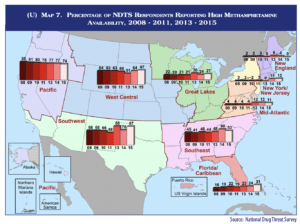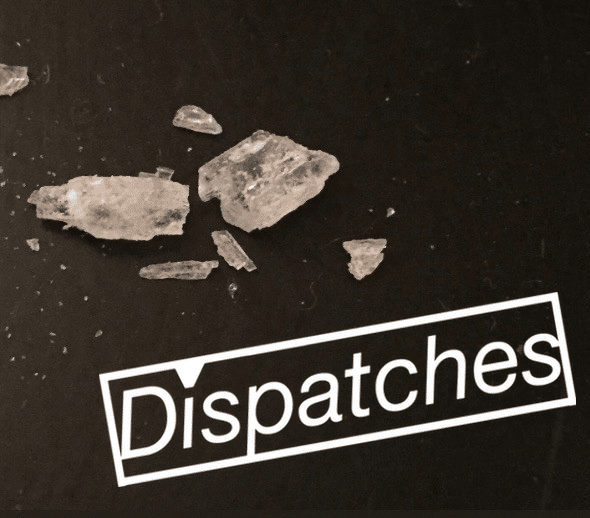Meth! Meth, crystal. Who wants meth?” shouted a middle-aged man in a parka earlier this month. He had situated himself on an alcove overlooking a small side street next to “Emerald City”—a busy drug-user encampment in Philadelphia’s East Kensington section.
Across the street a small cluster of men and women sat on a low wall, huddled against the cold, preparing shots of fentanyl-laced heroin or smoking “hard”—the street name here for crack cocaine. After a few moments, a young woman lifted her head quizzically.
“Crystal meth? I’d like to try it.”
“Try it?” the man said. “You can try it if you buy it.”
A year ago this exchange would have been inconceivable on the streets of Kensington—even though they have echoed for decades with the shouts of dealers hawking branded heroin and almost every other mood-altering drug, from PCP (or “wet”) to prescription pills.
Because until quite recently, Kensington was all but devoid of crystal meth—a drug so ubiquitous elsewhere in the US that it spawned its own Emmy-award winning TV series, with one of the most recognizable antiheroes in television history.
This DEA graphic illustrates the previous relative scarcity of meth across the Northeast:

Since 2016, however, Philadelphia’s drug markets have undergone a radical change. As illicitly made fentanyl has displaced heroin as king—cutting the local price of a bag of dope in half, from $10 to $5, in under a year—IV drug users’ concurrent use of stimulants such as powder and crack cocaine has surged.
This is partly because, with Colombian coca production at record levels, cocaine is more readily available on Philly’s streets than at any time since the introduction of crack.
It’s also for consumer-related reasons. Now that fentanyl is present in just about all of the city’s heroin, some heroin users tell me that coke counters the sedating effect fentanyl can produce. Others say they are simply taking advantage of an unexpected price-drop to get more bang for their buck by “speedballing”—mixing cocaine and fentanyl-laced heroin together—or else just using powder cocaine or crack in between fixes.
The Rise of Meth in Philly
But a recent flood of methamphetamine, sold by pop-up street dealers or through connections made on the narrow thoroughfares around Kensington Ave., caught everyone by surprise.
“We are starting to pull more and more meth at car stops,” volunteered a Philadelphia cop I encountered last August at the scene of a fentanyl overdose. “I’ve never seen this much meth in Philly.”
“I remember snorting crank back in the ‘80s. It burned like hell; we would go dancing all night,” said a local EMT who calls herself the “Narcan Queen” for the high number of opioid overdoses she encounters. “I’ve done this job for 15 years and we are definitely seeing an increase in calls for meth.”
According to James Garrow, a spokesman for the Philadelphia Department of Public Health, drug deaths in which toxicology reports showed methamphetamine rose between 2015 and 2017, but remained stable in 2018.
“The number is still small,” said Garrow. “Only about six percent of drug deaths in Philadelphia last year were positive for methamphetamine—and most of these were also positive for one or more opioids.”
But street sales of meth are increasing, as evidenced by many recent exchanges like the one near Emerald City; and I suspect that given the opportunity, more IV drug users will favor the cheap, sustained high of methamphetamine over the short rush of IV cocaine.
This was the first time I had seen crystal meth.
I first became aware of an emerging meth market in Kensington in early 2018, during one of my regular visits to one of four tent cities that sprang up almost overnight as law enforcement cracked down on other, less visible user camps. I was sitting in the tent of one of my sources when a young woman came in. She wanted to inject in her neck, and needed his assistance.
“Speedball?” I asked. (There is a belief among many IV drug users that the rush from cocaine is more powerful when administered this way.)
“No, it’s dope and crystal,” she replied. “Meth.”
In exchange for his help, the young woman left my source a small piece of the drug. The meth was so clear and finely formed that it looked like a precious gemstone in the palm of his hand. After nearly a decade covering East Coast drug markets, this was the first time I had seen crystal meth, or “ice,” as it was called when it first made headlines in the 1990s.
By summer 2018 it was clear this wasn’t an anomaly. A new pipeline was funneling methamphetamine into Kensington. The drug was cheap (going for as little as $70 a gram) and, according to users, highly potent.
Philly’s Old Meth Scene and Its Demise
The City of Brotherly Love was not always a stranger to meth. But the off-white “crank” of yesteryear looked nothing like the piece of “glass” I examined in the tent that day.
For decades Philly’s meth trade was firmly under control of outlaw motorcycle clubs—largely the Pagans (who maintained a strong presence in Philadelphia), but also the Warlocks, who until recently still operated a clubhouse in Fishtown, just south of Kensington.
These gangs worked with the Irish mob and their Kensington associates in the K&A Gang on the production and distribution end—and also with the Italian Mafia, which trafficked phenyl-2-propanone, (P2P), a precursor chemical for making meth, on the supply side.
True to long-established patterns of unintended consequences, the crackdown pushed manufacturing away from small-to-mid-sized operations in the US to “superlabs” south of the border.
As the War on Drugs accelerated during Bill Clinton’s presidency, however, Washington unleashed an assault on domestic meth production. In 1996 Congress passed the Comprehensive Methamphetamine Control Act, tightening controls on precursor chemicals and earmarking money for additional DEA agents. Janet Reno, Clinton’s Attorney General, promised to eradicate domestic meth production, and by that measure the effort was largely a success. Lab seizures plummeted in the US, and the virtual disappearance of P2P forced meth cooks to rely on a limited supply of pseudoephedrine.
But the crackdown—true to long-established patterns of unintended consequences—ultimately pushed manufacturing away from small-to-mid-sized operations in the US to “superlabs” south of the border. These were found largely in the western Mexican state of Jalisco, where cartels consolidated control over the ports and precursor chemicals like pure ephedrine, shipped from China. The labs began pumping out a potent, smokable form of d-methamphetamine, which quickly spread throughout the western US.
According to one federal law enforcement source who spent years busting meth labs, the average purity of meth seized prior to the crackdown on domestic production was 40-50 percent or less. Once Mexican cartels became the dominant suppliers in the early 2000s, purity shot to 80 percent and up.
By then Philadelphia’s old-school meth trade was on life support. The first to go down were 19 members of the Philly mob, including then-boss Nicodemo Scarfo, who were convicted of a raft of charges including drug trafficking in 1988.
Over the next decade feds would zero in on the K&A Gang and their outlaw biker associates. In 1998, nine defendants—including ringleader Thomas Zaroff Sr., who lived in East Kensington—were arrested and charged with distributing hundreds of pounds of meth, some of which they manufactured in a lab in Delaware.
After that methamphetamine became a low priority for law enforcement in the Philadelphia area, simply because there was so little of it around. In 2009, Zaroff’s son was indicted for allegedly facilitating a shipment of meth from Mexico for a federal informant. But crystal meth remained on the fringes of Phily drug culture.
Factors Behind the New Surge
Then came fentanyl, accompanied by a surge of new activity along the traditional heroin trafficking corridor, running north along I-95, through Atlanta, and into the Northeast.
The stage for synthetic drugs to flood into the Northeast had been set long previously. By 2004, US-led efforts to stem the flow of Colombian heroin and cocaine through the Caribbean (and into Miami for shipment north) encouraged the development of trafficking routes for South American drugs through Mexico.
Over the next decade, with the help of Colombian “cooks,” or cocineros, Mexican cartels learned to produce the highly refined white heroin favored by Americans east of the Mississippi. As US states began easing their marijuana policies, poppies quickly replaced bulky brick weed as the leading cash crop for illicit drug production south of the border.
Yet Mexico also rapidly became a hub for the production of synthetic drugs. Back in 2007, Mexican authorities raided a Toluca superlab operated by Ricardo Valdez, known as El Cerebro, or “the brain.” The lab had produced the fentanyl responsible for the first multi-state outbreak of overdoses of the drug, causing over a thousand fatalities in places like Chicago, Detroit, Philadelphia and Camden.
Unlike production of drugs made from organic plant material, producing synthetics means there’s no growing season to contend with.
There were several reasons for this switch to synthetics. Exponentially more potent than heroin, fentanyl is also easier to traffick; a single ounce can pack the punch of an entire kilo of heroin. And unlike production of drugs made from organic plant material, such as heroin and cocaine, producing synthetics means there’s no growing season to contend with. According to one report, Mexican superlabs can produce over 12 pounds of methamphetamine per day.
Federal officials last year identified crystal meth as the number one “threat” facing the Atlanta metro area. There, conversion labs reconstitute liquid methamphetamine smuggled across the southwest border into crystal for sale. A review of court records filed in Philadelphia and neighboring Montgomery County shows that Atlanta is a also major hub for heroin and fentanyl trafficked into the Northeast.
The reasons for this piggybacking of meth on the fentanyl trade remain largely theories. However, law enforcement sources have suggested to me that Mexican cartels, primarily the Jalisco New Generation Cartel (CJNG)—a powerful rival of the Sinaloa Federation that rose to prominence in the past eight years and controls much of the synthetic drug trade—are pressuring middlemen to traffick meth as a condition of buying the fentanyl the cartels produce or control. This could simply be a way of diversifying their profitable portfolio.
Locally, one lifelong Kensington resident with ties to the outlaw biker community tells me that a recent alliance between local Latino drug distributors and biker gangs has forged a new power structure in the North Philly underworld. This alliance, according to this source, now controls a formidable portion of the drug trade. (In 2013 The Outlaws, one of the oldest motorcycle clubs in the US, christened a new, fortress-like clubhouse in East Kensington).
One thing that is certain is that the latest resurgence of meth in Kensington landed in a community already flooded with cheap synthetic drugs. And if drug war history has taught us anything, problems are likely to increase before the situation improves.
Main photo by Christopher Moraff




